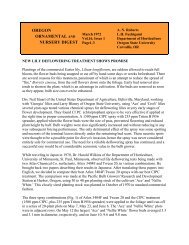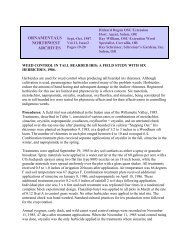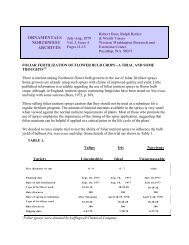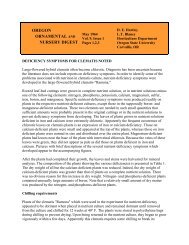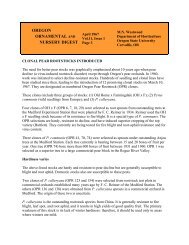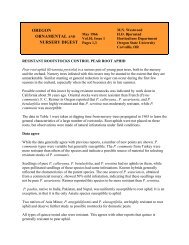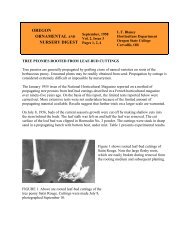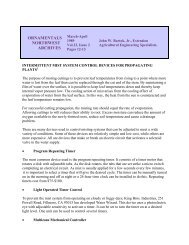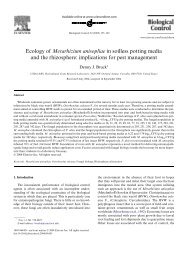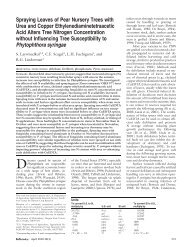Douglas-Fire Needle Midge.....Determining a Spray Schedule ...
Douglas-Fire Needle Midge.....Determining a Spray Schedule ...
Douglas-Fire Needle Midge.....Determining a Spray Schedule ...
Create successful ePaper yourself
Turn your PDF publications into a flip-book with our unique Google optimized e-Paper software.
ORNAMENTALS<br />
NORTHWEST<br />
ARCHIVES<br />
Jan.-Feb.-Mar.<br />
1982<br />
Vol. 6, Issue 1<br />
Pages 8-10<br />
Ben Simko, Extension Pest Management<br />
Specialist, and Bill Proebsting, Extension<br />
Christmas Tree Specialist, Oregon State<br />
University. Corvallis, OR 97331<br />
DOUGLAS-FIR. NEEDLE MIDGE ... <strong>Determining</strong> a <strong>Spray</strong> <strong>Schedule</strong> Through Use of a<br />
<strong>Midge</strong> Trap<br />
Three related species of flies, Contarinia pseudotsugae, Contarinia costricta, and Contarinia<br />
cuniculator have caused serious damage to some Northwest <strong>Douglas</strong>-fir Christmas tree<br />
plantations. Collectively these species are commonly called <strong>Douglas</strong>-fir needle midges.<br />
Periodically, large portions of important production regions have been severely infested resulting<br />
in deformed, discolored needles, and in some cases premature needle drop (Figure 1). With<br />
growth and development of Christmas tree plantations, these midges have attracted increased<br />
attention as pests of economic significance.<br />
Damage can make the trees unsightly and unfit for<br />
market. Whether midge populations and their damage<br />
have increased over the last few seasons is not known,<br />
but Northwest Christmas tree growers should be on the<br />
alert this spring in case control is required.<br />
Figure 1. <strong>Needle</strong> galls on <strong>Douglas</strong>-fir<br />
caused by: A, Contarinia<br />
cuniculator; B, Contarinia<br />
constricta; and, C, Contarinia<br />
pseudotsugae.<br />
Description of <strong>Midge</strong><br />
Adults: The adult midges are delicate, orange, twowinged<br />
flies about one-eighth inch long. Adult<br />
females are stout and have a long ovipositor.) Adult<br />
life span is short; males live 1-2 days after<br />
emergence. Females live 2-4 days.<br />
Figure 2. Adult female <strong>Douglas</strong>fir<br />
needle midge is distinguished<br />
by her long ovipositor.
Eggs The female flies lay eggs on the surface of new needles where they itch in a few days.<br />
Larvae: The newly emerging larvae quickly enter the needle and feed throughout the summer.<br />
Larvae of each species cause slightly different needle damage (see Figure 1). All three forms,<br />
however, mine the needle, often several larvae being present in one needle, and form gall-like<br />
structures. The needles become discolored, ranging from yellowish to purple. When mature, the<br />
larvae are about one-eighth inch long and yellowish, white or orange in color. Larvae leave the<br />
needles in the fall and over-winter in the soil.<br />
Figure 3. Feeding damage and<br />
exposed larvae in <strong>Douglas</strong>-fir<br />
needles. This stage of life cycle<br />
can be found in late summer or<br />
early fall.<br />
Larvae emerge the following spring as adults from the ground beneath the host trees about the<br />
time <strong>Douglas</strong>-fir buds are bursting.<br />
Timing for application of an insecticide, however, should be determined not by observing bud<br />
development, but by monitoring emergence. Because of the long interval of <strong>Douglas</strong>-fir bud<br />
break in Christmas tree plantations, lasting three weeks or more, needle length should not be<br />
used as a criteria.<br />
The most reliable means of determining emergence is the use of an emergence trap. The<br />
emergence period during which adults emerge from the larvae that over-wintered in the soil is of<br />
relatively short duration, approximately 10 days. Life span of the adults ranges from 1-4 days.<br />
Insecticide treatment should be timed to coincide with the period of adult female midge<br />
emergence.<br />
Construction of an Emergence Trap<br />
A trap can be constructed using any weather resistant material such as sheet metal, plywood, or<br />
heavy cardboard (wax coated shipping boxes are ideal). Construct or use a box with at least a 15<br />
inch square opening on one side. Several inches from the bottom on one side of the box, cut a<br />
circular hole slightly smaller than the lid of a wide mouth glass jar. A pint or quart size Mason<br />
jar works well. Secure the collection jar to the side of the box. When this trap is placed on the<br />
ground close to a tree, the emerging midges are attracted to the light and enter the jar.<br />
Condensation makes it necessary to place paper toweling in the jar. The trapped midges come to<br />
rest on the paper, and this facilitates counting. Set the trap on the north side of a tree in an area<br />
where damage has been observed. In large plantations where differences in elevation or sun<br />
exposure exist, additional trap locations may be indicated to monitor variations in midge<br />
emergence due to microclimate differences.
Trapping of midges should begin prior to first bud breaking of <strong>Douglas</strong>-fir to determine any<br />
sharp increase in emergence. Daily checks of the trap will reveal if an increase of midges occurs<br />
and particularly the onset of female emergence.<br />
Controls<br />
Chemical Control<br />
Thiodan and Orthene, two insecticides registered on <strong>Douglas</strong>-fir, are effective against needle<br />
midge. Use Thiodan 50 WP or 2 EC at the rate of two pounds active ingredient per acre. Thiodan<br />
will also control aphids and susceptible stages of adelgids at the time of application. Or, use<br />
Orthene 75 SP at the rate of 0.5 pounds active ingredient per acre. Both insecticides can be<br />
applied with ground equipment using sufficient water to thoroughly wet trees; by aircraft, use 5-<br />
10 gallons of water per acre. Insecticide treatment should be timed to coincide with the period of<br />
adult female midge emergence.<br />
Survey the plantation carefully. Frequently midge infestations begin at the perimeters of the<br />
planting. Perimeter applications may be adequate to stop infestation spread to the remainder of<br />
the stand. If good control is achieved (and this can be determined in August or September),<br />
additional applications the second and third year may not be necessary. A decision on<br />
whether to spray the following year can be determined by the number of midges caught.<br />
Figure 4. Damaged needles in late<br />
summer and fall. Look for swollen<br />
gall-like areas and yellowish to<br />
purple discoloration.<br />
Cultural Control<br />
Tests have shown that advanced <strong>Douglas</strong>-fir buds become significantly more heavily infested<br />
than retarded buds..the tree which leafed out two weeks earlier was heavily attacked while the<br />
other was hardly affected. Phenological asynchronism of insect and host may result in<br />
considerable mortality to eggs and young larvae. Nevertheless, if midge populations are high,<br />
there may be enough late emergents to infest the later new needles. "This suggests that selection<br />
may be possible of suitable planting stock for use in areas subject to recurrent midge attack."<br />
With bud break delayed as much as 2 weeks after normal for that area, the peak of midge<br />
emergence would be out of synch and damage thus reduced. (Condrashoff, 1962).<br />
Physical Controlling Factors<br />
Unfavorable spring weather may result in mechanical injury to adults. Their legs, wings, and<br />
antennae are easily damaged by collision with hail, rain and objects moved by strong winds.
Biological Control<br />
"...about 75 percent of the overwintering midge larvae were parasitized by Platygaster<br />
sp."(Condrashoff, 1962). The parasite larva develops slowly and overwinters inside the midge<br />
larvae. The following spring, before the midge larva pupates, the parasite develops rapidly and<br />
makes a cocoon from the midge larva's skin. The adult parasite emerges several weeks after<br />
emergence of the adult midge. However, Contarinia pseudotsugae, the most common midge on<br />
the <strong>Douglas</strong>-fir, apparently resists parasitism to some extent by encapsulating parasite eggs in the<br />
body with a sclerotized layer that prevents hatching. Even so, parasitism may destroy a large<br />
proportion of the midge larvae (Condrashoff, 1962). The delayed emergence of the parasite in<br />
the spring (parasite emerges several weeks after the adult midge emerges) is another reason for<br />
trapping so chemical spray application can be closely timed to coincide with peak emergence of<br />
adult female midges. <strong>Spray</strong>s should not be applied so late as to miss the adult female midge and<br />
wipe out the later emerging parasites.<br />
References:<br />
Condrashoff, S.F. 1962. Bionomics of three closely related species of Contarinia Rond.<br />
(Diptera: Cecidomyiidae from <strong>Douglas</strong>-fir needles. The Canadian Entomologist 94(4):376-394.<br />
Nagel, N.P. 1968. <strong>Douglas</strong>-fir needle midge control. Northwest Lookout, Nov. 1968.<br />
Pesticide Use - Due to constantly changing laws and regulations, no liability for the suggested use of chemicals in<br />
this Newsletter is assumed by the ONW Newsletter. Pesticides should be applied according to label directions on the<br />
pesticide container.<br />
Permission to Reprint material appearing in the ONW Newsletter is granted with the request that you credit the<br />
source: Ornamentals Northwest Newsletter, date, volume, issue, page numbers. Do not excerpt or reprint in such a<br />
manner as to imply the author's endorsement or criticism of a product or concept.<br />
Nondiscrimination - The information in the Ornamentals Northwest Newsletter is provided with the understanding<br />
that no discrimination is intended and that listing of commercial products implies no endorsement by the authors.<br />
Criticism of products or equipment is neither intended nor implied.





